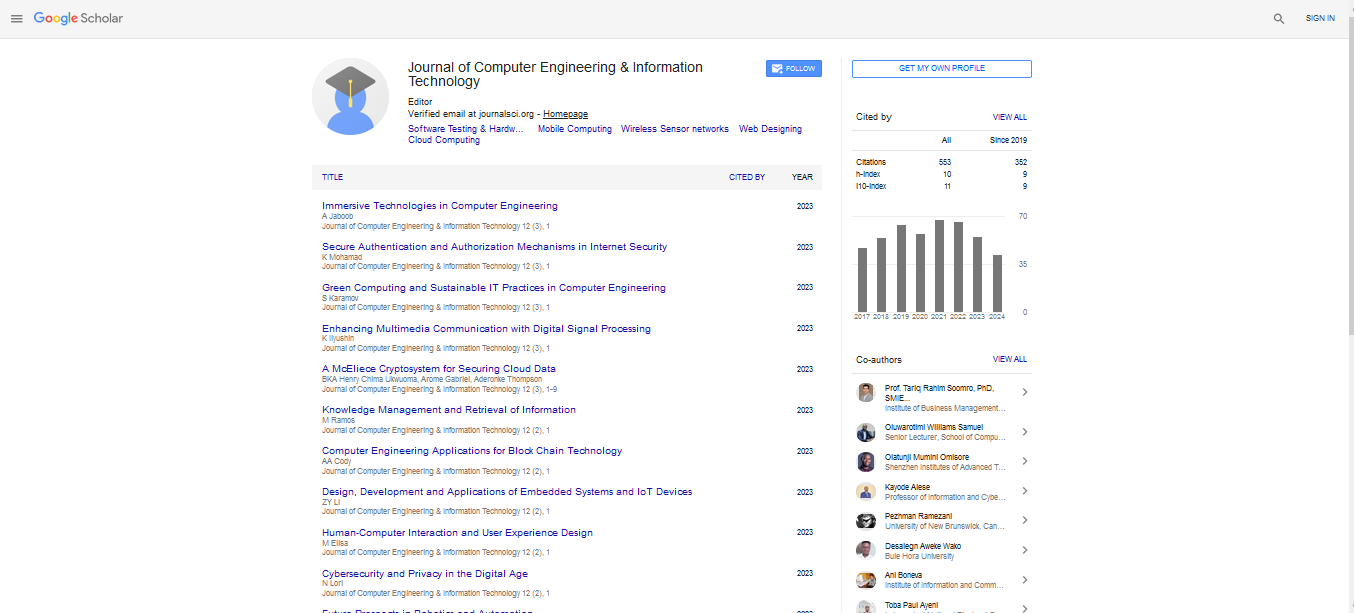Editorial, Jceit Vol: 14 Issue: 2
Robotics: The Science of Automated Machines
Sheralin Zeada*
College of Communication and Information Technology, University of Kentucky, United States
- *Corresponding Author:
- Sheralin Zeada
College of Communication and Information Technology, University of Kentucky, United States
E-mail: zeada_sheralin@yahoo.com
Received: 01-March-2025, Manuscript No jceit-25-169322; Editor assigned: 4-March-2025, Pre-QC No. jceit-25-169322 (PQ); Reviewed: 20-March-2025, QC No jceit-25-169322; Revised: 27-March-2025, Manuscript No. jceit-25-169322 (R); Published: 31-March-2025, DOI: 10.4172/2324-9307.1000343
Citation: Sheralin Z (2025) Robotics: The Science of Automated Machines. J Comput Eng Inf Technol 14: 343
Introduction
Robotics is a multidisciplinary field that combines engineering, computer science, and artificial intelligence to design, build, and operate robots—machines capable of performing tasks autonomously or semi-autonomously. The field has evolved significantly over the past few decades, transforming industries from manufacturing to healthcare, and shaping the future of automation and intelligent systems. Robotics blends mechanical design, electronics, control theory, and software engineering to create systems that enhance productivity, safety, and quality of life.
What is Robotics?
Robotics involves the conception, design, manufacture, and application of robots. Robots are programmable machines that can carry out a series of actions automatically. Modern robots range from simple mechanical arms used in assembly lines to complex humanoid robots capable of interacting with humans and environments intelligently.
Key aspects of robotics include:
Mechanical Design: The physical structure of robots, including joints, actuators, and sensors.
Control Systems: Algorithms and electronics that govern the robot’s motion and actions.
Perception: Use of sensors such as cameras, lidar, and tactile sensors to interpret surroundings.
Artificial Intelligence: Enables robots to make decisions, learn from experiences, and adapt to changes.
Types of Robots
Robots can be classified based on their application and mobility:
Industrial Robots: Used in manufacturing for tasks like welding, painting, and assembly.
Service Robots: Designed for tasks such as cleaning, delivery, and medical assistance.
Autonomous Vehicles: Self-driving cars and drones that navigate without human intervention.
Humanoids: Robots designed to resemble and interact with humans.
Exploratory Robots: Used in hazardous environments like space, underwater, or disaster zones.
Applications of Robotics
Robotics technology has permeated many sectors:
Manufacturing: Automation of repetitive tasks improves efficiency and safety.
Healthcare: Surgical robots assist in precise operations; rehabilitation robots support patient recovery.
Agriculture: Robots automate planting, harvesting, and monitoring crops.
Military and Security: Unmanned systems for reconnaissance and bomb disposal.
Entertainment: Robots as interactive toys and performers.
Challenges and Future Trends
While robotics holds immense promise, several challenges remain:
Complexity: Developing robots that can handle unstructured, dynamic environments.
Cost: High development and maintenance expenses limit adoption.
Ethics and Safety: Ensuring robots operate safely alongside humans and make ethical decisions.
Human-Robot Interaction: Improving communication and cooperation between humans and robots.
Future trends include:
Collaborative Robots (Cobots): Robots designed to work safely alongside humans.
AI Integration: Enhancing autonomy and decision-making.
Soft Robotics: Using flexible materials to mimic biological organisms.
Swarm Robotics: Coordinated operation of multiple robots for complex tasks.
Conclusion
Robotics stands at the frontier of technological innovation, blending multiple disciplines to create machines that enhance human capabilities and automate complex tasks. From industrial automation to personal assistance, robots are transforming how we live and work. As research continues to overcome current limitations, robotics will play an increasingly vital role in shaping a smarter, safer, and more efficient future.
References
- Gartner (2023) Magic Quadrant for Full Life Cycle API Management.
- Postman (2024) The State of API Integration 2024 Report.
- Apigee (2023) API Management Best Practices.
- MuleSoft (2023) What is API Management?
- ProgrammableWeb (2024) API Security Challenges and Trends.
Indexed at, Google Scholar, Crossref
Indexed at, Google Scholar, Crossref
Indexed at, Google Scholar, Crossref
Indexed at, Google Scholar, Crossref
 Spanish
Spanish  Chinese
Chinese  Russian
Russian  German
German  French
French  Japanese
Japanese  Portuguese
Portuguese  Hindi
Hindi 